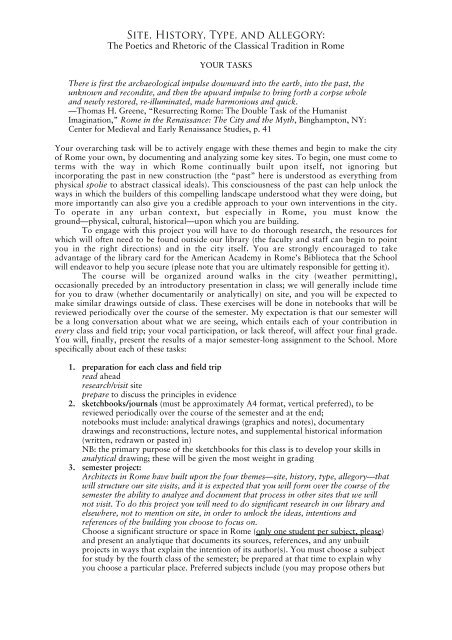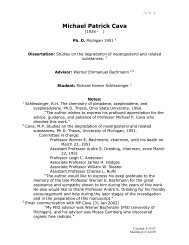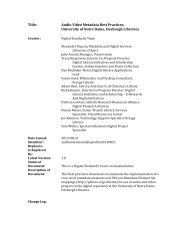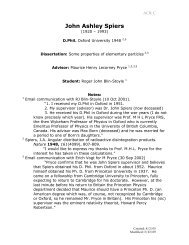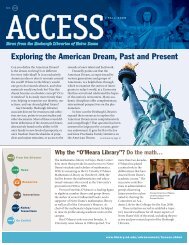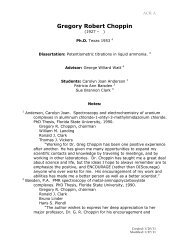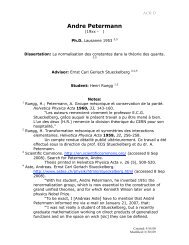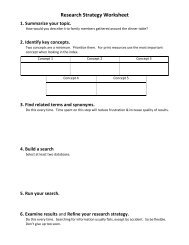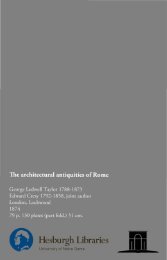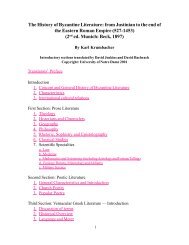ARCH 84312
ARCH 84312
ARCH 84312
You also want an ePaper? Increase the reach of your titles
YUMPU automatically turns print PDFs into web optimized ePapers that Google loves.
Site, History, Type, and Allegory:<br />
The Poetics and Rhetoric of the Classical Tradition in Rome<br />
YOUR TASKS<br />
There is first the archaeological impulse downward into the earth, into the past, the<br />
unknown and recondite, and then the upward impulse to bring forth a corpse whole<br />
and newly restored, re-illuminated, made harmonious and quick.<br />
—Thomas H. Greene, “Resurrecting Rome: The Double Task of the Humanist<br />
Imagination,” Rome in the Renaissance: The City and the Myth, Binghampton, NY:<br />
Center for Medieval and Early Renaissance Studies, p. 41<br />
Your overarching task will be to actively engage with these themes and begin to make the city<br />
of Rome your own, by documenting and analyzing some key sites. To begin, one must come to<br />
terms with the way in which Rome continually built upon itself, not ignoring but<br />
incorporating the past in new construction (the “past” here is understood as everything from<br />
physical spolie to abstract classical ideals). This consciousness of the past can help unlock the<br />
ways in which the builders of this compelling landscape understood what they were doing, but<br />
more importantly can also give you a credible approach to your own interventions in the city.<br />
To operate in any urban context, but especially in Rome, you must know the<br />
ground—physical, cultural, historical—upon which you are building.<br />
To engage with this project you will have to do thorough research, the resources for<br />
which will often need to be found outside our library (the faculty and staff can begin to point<br />
you in the right directions) and in the city itself. You are strongly encouraged to take<br />
advantage of the library card for the American Academy in Rome’s Biblioteca that the School<br />
will endeavor to help you secure (please note that you are ultimately responsible for getting it).<br />
The course will be organized around walks in the city (weather permitting),<br />
occasionally preceded by an introductory presentation in class; we will generally include time<br />
for you to draw (whether documentarily or analytically) on site, and you will be expected to<br />
make similar drawings outside of class. These exercises will be done in notebooks that will be<br />
reviewed periodically over the course of the semester. My expectation is that our semester will<br />
be a long conversation about what we are seeing, which entails each of your contribution in<br />
every class and field trip; your vocal participation, or lack thereof, will affect your final grade.<br />
You will, finally, present the results of a major semester-long assignment to the School. More<br />
specifically about each of these tasks:<br />
1. preparation for each class and field trip<br />
read ahead<br />
research/visit site<br />
prepare to discuss the principles in evidence<br />
2. sketchbooks/journals (must be approximately A4 format, vertical preferred), to be<br />
reviewed periodically over the course of the semester and at the end;<br />
notebooks must include: analytical drawings (graphics and notes), documentary<br />
drawings and reconstructions, lecture notes, and supplemental historical information<br />
(written, redrawn or pasted in)<br />
NB: the primary purpose of the sketchbooks for this class is to develop your skills in<br />
analytical drawing; these will be given the most weight in grading<br />
3. semester project:<br />
Architects in Rome have built upon the four themes—site, history, type, allegory—that<br />
will structure our site visits, and it is expected that you will form over the course of the<br />
semester the ability to analyze and document that process in other sites that we will<br />
not visit. To do this project you will need to do significant research in our library and<br />
elsewhere, not to mention on site, in order to unlock the ideas, intentions and<br />
references of the building you choose to focus on.<br />
Choose a significant structure or space in Rome ( only one student per subject, please)<br />
and present an analytique that documents its sources, references, and any unbuilt<br />
projects in ways that explain the intention of its author(s). You must choose a subject<br />
for study by the fourth class of the semester; be prepared at that time to explain why<br />
you choose a particular place. Preferred subjects include (you may propose others but


